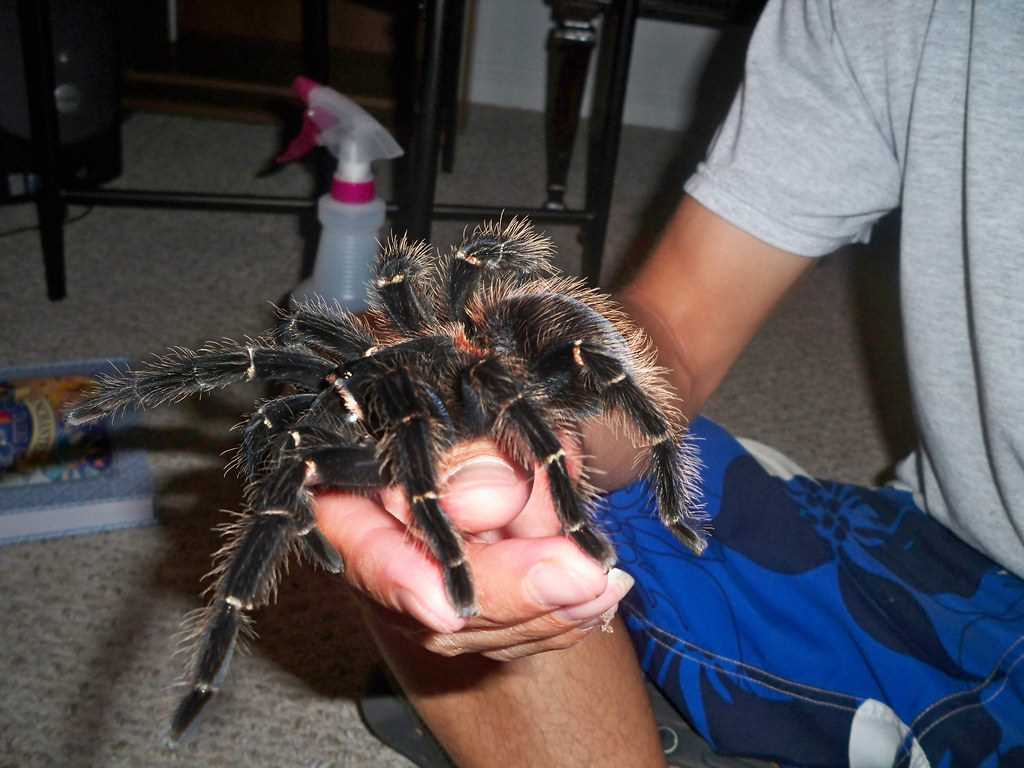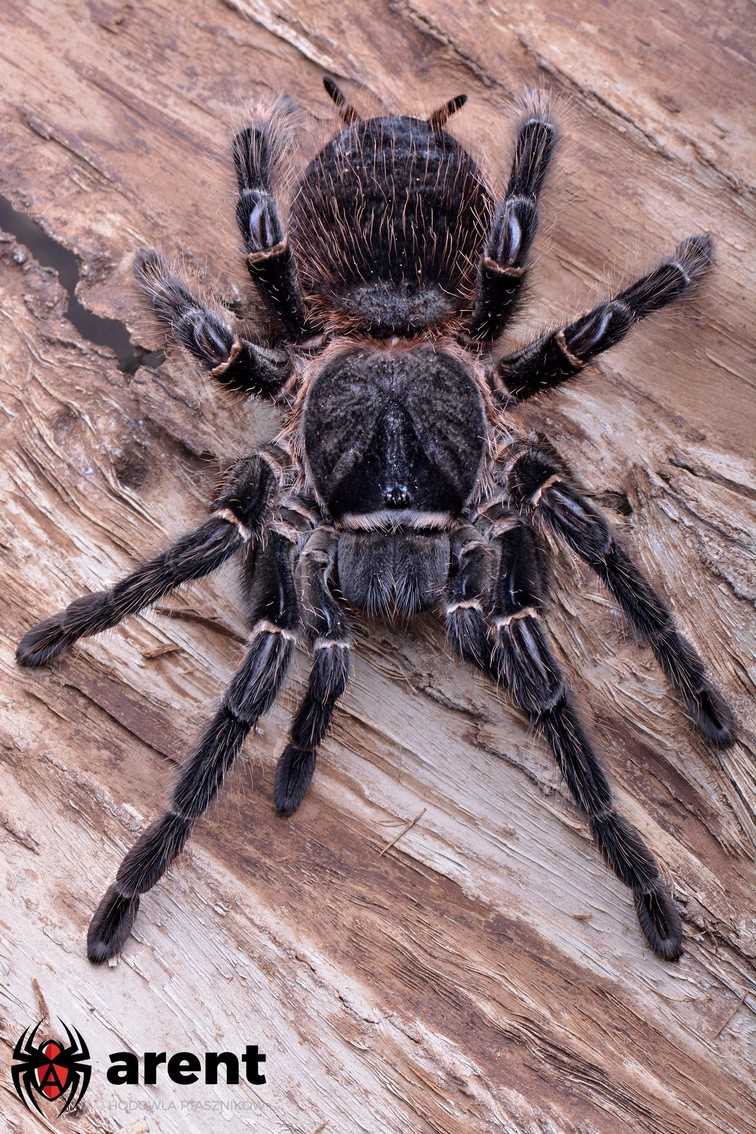If you are a tarantula lover, then you must have heard about the Lasiodora parahybana or the Brazilian salmon pink tarantula. This beautiful and hairy spider is one of the largest tarantulas in the world, native to Brazil. Its large size, exotic appearance, and docile nature make it a popular choice among arachnid enthusiasts as a pet.
Interesting facts about the Lasiodora parahybana include its ability to flick urticating hairs as a defense mechanism. These tiny barbed hairs can cause irritation and discomfort to any potential threats. Additionally, this tarantula is known for its longevity, with a lifespan that can exceed 20 years in captivity. It is also important to note that the Brazilian salmon pink tarantula is a protected species in its native habitat, making it illegal to export them without proper permits.
The Natural Habitat of the Lasiodora parahybana: A Big, Exotic Brazilian Tarantula
In its natural habitat, the Lasiodora parahybana can be found in the tropical rainforests and grasslands of northeastern Brazil. These spiders prefer areas with a warm and humid climate, where they can thrive and find abundant food sources.
The most striking feature of the Lasiodora parahybana is its size. Adult females can reach a leg span of up to 10 inches, making them a truly impressive sight. Their bodies are covered in dense, orange-brown hairs, which give them a beautiful and luxurious appearance.
This tarantula species constructs burrows in the ground or creates homes in hollow trees and logs. They use these shelters to hide during the day and to retreat to during mating or molting periods. The burrows are lined with silk, which provides stability and security.
Providing a suitable terrarium setup for your Lasiodora parahybana is crucial to their well-being. It should replicate their natural habitat as closely as possible, with a spacious enclosure, substrate for burrowing, and hiding spots. The terrarium should also have proper ventilation and be secure to prevent any escape attempts.
Physical Characteristics of Lasiodora parahybana
Lasiodora parahybana has a dark reddish-brown body covered in dense, copper-colored hairs, which give it its distinctive salmon pink hue. The abdomen is round and plump, and it has eight long, hairy legs. The cephalothorax, which is the fused head and thorax, is also covered in dense hairs.
This species is sexually dimorphic, meaning that males and females have different physical characteristics. Adult males are typically smaller and have a more slender body compared to the females. Additionally, males have specialized appendages on their pedipalps, which they use to transfer sperm to the female during mating.
Lasiodora parahybana also has a pair of large, forward-facing eyes that are well-adapted for hunting. These spiders have excellent vision and are able to track prey with precision.
Overall, the physical characteristics of Lasiodora parahybana make it an impressive and captivating specimen for enthusiasts of exotic spiders.
Feeding Habits of Lasiodora parahybana
It’s essential to ensure that the feeding area is clean and free from any leftover prey items. If uneaten prey remains in the enclosure, it should be removed to prevent any potential health issues or cage contamination.
In addition to a proper diet, it’s crucial to provide fresh water for your Lasiodora parahybana. A shallow water dish should be available at all times to allow the tarantula to drink and maintain hydration.
Overall, the feeding habits of the Lasiodora parahybana showcase their predatory nature and provide an opportunity to observe their natural behaviors. With proper care and a suitable diet, these beautiful and exotic tarantulas can thrive as pets and captivate their owners with their unique feeding rituals.
Terrarium Setup for Lasiodora parahybana
The substrate is another important aspect of the terrarium setup. A layer of peat moss or coconut fiber substrate should be added, providing a soft and moist environment that Lasiodora parahybana will appreciate. This substrate also helps with maintaining the proper humidity levels within the enclosure.
The terrarium should also include hiding spots for Lasiodora parahybana. This can be achieved by adding pieces of bark, cork bark, or even small flower pots that are partially buried in the substrate. These hiding spots provide the spider with a sense of security and allow it to retreat when it feels threatened.
Lastly, proper ventilation is essential in the terrarium. Adequate air circulation helps prevent stagnant air and maintains a healthy environment for Lasiodora parahybana. This can be achieved by adding ventilation holes to the sides or top of the terrarium, but care should be taken to ensure the spider cannot escape through these openings.
In summary, setting up a terrarium for your Lasiodora parahybana requires careful consideration of its natural habitat and needs. By providing a spacious enclosure with the appropriate substrate, humidity levels, hiding spots, climbing materials, and ventilation, you can create a suitable and comfortable environment for this beautiful Brazilian tarantula.
Temperature and Humidity Requirements
In terms of humidity, Lasiodora parahybana requires a moderately humid environment. Aim for a humidity level of around 60-70%. This can be achieved by misting the terrarium regularly with water, keeping a shallow water dish, or using a hygrometer to monitor and regulate the humidity levels. Providing proper ventilation is also essential to prevent excess moisture and the growth of harmful bacteria or fungi.
Remember, maintaining the correct temperature and humidity levels is essential for the well-being and longevity of your Brazilian Salmon Pink Bird-Eating Spider. By providing a comfortable and suitable environment, you can ensure that your hairy arachnid companion thrives and remains healthy for years to come.
Handling and Temperament of Lasiodora parahybana

1. Approach with Caution
When approaching the tarantula, do so slowly and gently. Sudden movements may startle the spider and cause it to become defensive.
2. Use Proper Handling Techniques
3. Be Mindful of the Tarantula’s Behavior
Before attempting to handle the tarantula, it’s essential to observe its behavior. If the spider is displaying signs of stress, such as rearing up or flicking its urticating hairs, it is best to avoid handling it altogether.
4. Take Precautionary Measures
It is recommended to wear gloves and long sleeves when handling a Lasiodora parahybana to protect yourself from potential bites or urticating hairs. Additionally, make sure the area where you handle the tarantula is secure and free from any potential hazards.
5. Avoid Handling During Molting

During molting, tarantulas are particularly vulnerable and should not be handled. It is crucial to give them space and allow them to complete the molting process undisturbed.
| Pros of Handling | Cons of Handling |
|---|---|
|
|
While handling a Lasiodora parahybana can be an exciting and rewarding experience, it is essential to prioritize the well-being of the spider above all else. Always approach handling with caution and respect for the tarantula’s natural temperament and needs.
Reproduction and Lifespan of Lasiodora parahybana
Once the female accepts the male’s advances, mating will occur. During this process, the male will transfer sperm to the female using specialized structures called pedipalps. After mating, the female will lay a sac of eggs that she guards fiercely until they hatch. The eggs typically hatch after several weeks, and the young spiderlings emerge.
The lifespan of Lasiodora parahybana is quite long compared to other spider species. Females can live up to 20 years or more, while males have a significantly shorter lifespan of around 5-7 years. This difference in lifespan is due to the males’ decreased nutritional intake during their maturation process and their higher rate of activity, which leads to faster aging.
Common Health Issues in Lasiodora parahybana
One of the most common health problems encountered in Lasiodora parahybana is dehydration. These spiders require a humid environment, and if the humidity levels are too low, they may become dehydrated. Dehydration can lead to a range of issues, including a weakened immune system and difficulty molting. To prevent dehydration, it is essential to maintain the correct humidity levels in the tarantula’s terrarium.
Respiratory issues are also a concern for Lasiodora parahybana. While these spiders do not have lungs like mammals, they still require oxygen to breathe. If the tarantula’s enclosure is too damp or poorly ventilated, it may develop respiratory problems. Signs of respiratory issues include wheezing, labored breathing, and lethargy. To prevent respiratory problems, ensure proper ventilation and avoid over-misting the terrarium.
Interesting Facts about Lasiodora parahybana
1. Impressive Size
The Lasiodora parahybana is one of the largest tarantula species in the world, with females reaching a legspan of up to 10 inches (25 cm). This impressive size contributes to its captivating appearance and makes it a sight to behold.
2. Beautiful Colors
While its common name suggests a salmon pink color, the Lasiodora parahybana displays a range of vibrant colors throughout its body. These can vary from shades of copper, orange, and reddish-brown, making it a visually striking spider.
3. Surprising Speed
Contrary to its large size, the Lasiodora parahybana is surprisingly fast and agile. This agility allows it to quickly capture its prey in the wild and adds to its fascinating behavior when observed in captivity.
4. Burrowing Behavior
In its natural habitat, the Lasiodora parahybana displays burrowing behavior. It creates deep burrows in the ground, lined with thick silk, where it spends most of its time. This behavior can be replicated in a terrarium setup to provide a suitable habitat for the spider.
5. Long Lifespan
With proper care, the Lasiodora parahybana can live for an extended period of time. Females can reach a lifespan of up to 20 years, while males have a shorter lifespan of around 3-6 years. This longevity allows enthusiasts to enjoy the presence of these fascinating creatures for a significant portion of their lives.
6. Gentle Temperament
Despite its intimidating size, the Lasiodora parahybana has a reputation for being relatively docile and calm. With proper handling and care, they can become used to human presence, making them an interesting pet for those interested in observing and interacting with spiders.
7. Nocturnal Hunter
The Lasiodora parahybana is primarily a nocturnal hunter. It uses its impressive size and agility to capture a range of prey, including small insects, spiders, and even small rodents. Observing its hunting behavior can be both fascinating and educational.
8. Unique Defense Mechanism
Like many tarantula species, the Lasiodora parahybana has specialized defense mechanisms. When threatened, it can go into a defensive posture by raising its front legs and displaying its impressive fangs. It can also release urticating hairs from its abdomen, which can irritate the skin and eyes of potential predators.
9. Popular Species
The Lasiodora parahybana is a highly sought-after species among tarantula enthusiasts. Its impressive size, striking colors, and gentle temperament make it a popular choice for those interested in keeping and breeding tarantulas as pets.
10. Fascinating Reproduction
The reproductive behavior of the Lasiodora parahybana is highly intriguing. During mating, the male creates a sperm web which he then deposits onto a specially woven mat. He then transfers the sperm onto specialized appendages called palps and uses them to inseminate the female. The female can lay hundreds of eggs, which she guards and cares for until they hatch into tiny spiderlings.

I’m Lena Adams—a product of an unconventional upbringing in the African wilderness. My father, a daring explorer of African wildlife, sparked my fascination with reptiles, a passion that intertwined with the tragic loss of my mother during an expedition, leaving an indelible mark on my life. Driven to understand the creatures that captivated my parents, I embarked on my journey, sharing insights about reptiles, frogs, and lizards on my website. Through my explorations and conservation efforts, I honour my family’s legacy while seeking connections—to the creatures, nature, and the mother whose presence I yearn to understand.
